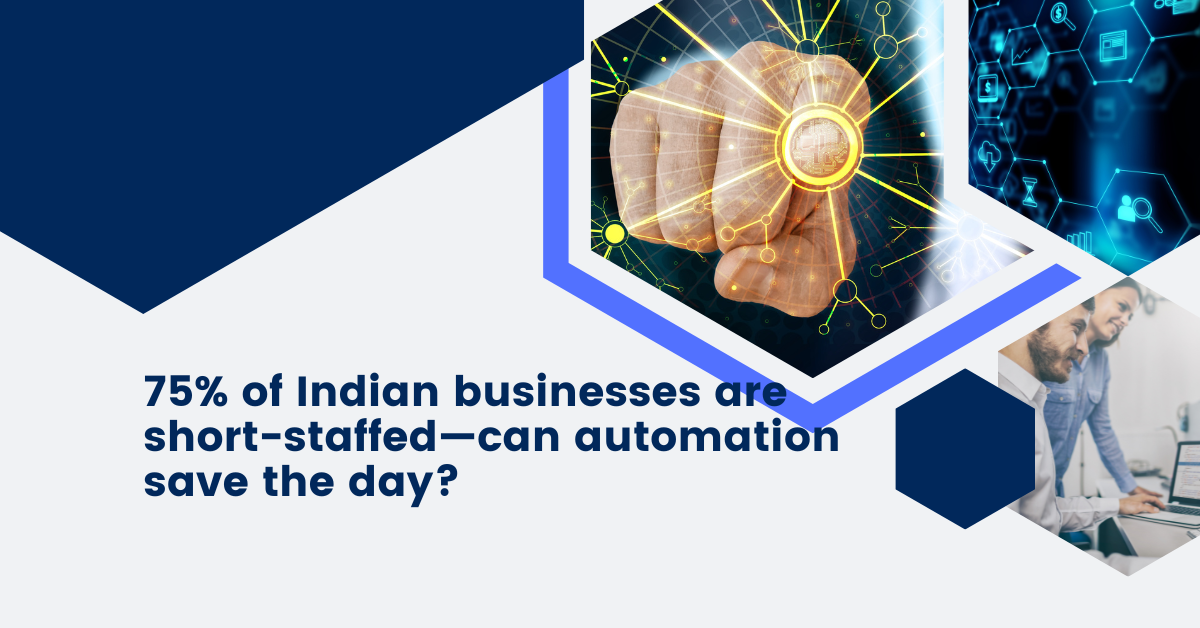75% of Indian businesses are short-staffed—can automation save the day?
Step into any HR department across India right now, and you’ll likely see payroll teams racing against the clock, managing endless calculations, compliance checklists, and error-prone spreadsheets to make sure salaries go out on time. It’s stressful, it’s complex, and for most companies, it’s getting worse.
According to ADP’s “Potential of Pay 2025” report, 75% of Indian businesses say they are dealing with payroll staff shortages—the highest across Asia-Pacific. This is a full-blown talent crunch that’s changing how companies approach payroll altogether.
The scope of the shortage
Let’s break it down: While three-quarters of companies say they are short on payroll talent, 93% are actively trying to hire more staff. It’s a classic supply-demand mismatch, and it’s hitting businesses hard—especially when payroll roles now require a rare mix of technical, compliance, and analytical skills.
With India’s regulatory landscape differing from state to state—and policies changing frequently—payroll pros need deep expertise in compliance, tax law, and multi-state labor norms. But there just aren’t enough people who fit the bill. And many of the few who do are moving into broader HR roles, further draining the talent pool.
Why the shortage is happening
The boom in India’s business ecosystem—especially among startups—has created a sudden spike in payroll complexity. A company that had 20 employees two years ago now has 500 spread across cities. Each one brings a new layer of tax rules, policies, and processes to manage.
Meanwhile, digital transformation has raised expectations. Today’s payroll staff are expected to be tech-savvy, familiar with cloud HRMS platforms, and capable of interpreting data analytics. Not everyone’s up to speed.
Add to that the post-pandemic surge in hybrid and remote work, and payroll gets even trickier. Distributed teams mean distributed compliance—and payroll teams are left scrambling to keep up.
The automation answer
With hiring alone proving insufficient, many Indian companies are shifting gears and turning to automation and AI to ease the burden. The ADP study shows that 68% of organizations are now using or planning to use AI to streamline payroll processes.
But here’s the key: this isn’t about replacing jobs but redefining them. Payroll automation isn’t removing people; it’s removing repetitive, manual tasks like calculations, data entry, and compliance checks. That leaves human experts free to focus on more strategic work.
In fact, India is leading the region in AI enthusiasm. 35% of Indian businesses see AI as the top enabler for payroll innovation over the next 2–3 years, the highest across the APAC market.
What automation can do
The power of automated payroll systems lies in their speed, consistency, and accuracy. They process data instantly, comply with local rules, and generate detailed reports—something that used to require a full team.
And they are proving effective: 38% of businesses blame payroll errors on the lack of automation, while 48% say poor data quality is a top concern. Automation directly tackles both problems by reducing manual inputs and validating data in real time.
The result? Fewer errors, better audits, less stress.
Skills are evolving fast
The kind of talent needed in payroll is also shifting. The traditional payroll expert with strong Excel skills isn’t enough anymore. Companies are now looking for professionals who understand automation tools, compliance dashboards, and data insights.
To bridge that skills gap, businesses are starting to invest in training programs that help staff upskill—merging traditional payroll knowledge with digital literacy and tech fluency.
A glimpse into the future
This payroll talent crunch is accelerating a major shift in how businesses manage their people and processes. We are heading into an era where automated payroll systems handle the mechanics, while humans focus on compliance strategy, risk mitigation, and analytics.
Soon, predictive analytics and machine learning will become standard payroll tools—helping HR forecast staffing costs, prevent compliance violations, and optimize resource planning well before problems arise.
What companies should do next
For Indian businesses, one thing is clear: the time to modernize payroll is now. Waiting for the talent market to correct itself is not a viable strategy. Instead, smart companies are adopting a multi-layered approach:
- Automate what can be automated, using AI to handle routine tasks.
- Partner with experts or outsourced providers for high-risk or cross-border payroll needs.
- Invest in internal training to develop versatile, tech-enabled payroll professionals.
This kind of balanced strategy ensures short-term stability while building long-term capability.
Beehive HRMS: A smarter way forward
At Beehive HRMS, we understand the unique challenges of the Indian payroll landscape. Our AI-powered payroll platform is designed to handle everything—from compliance and tax calculations to real-time reporting and error checks. We automate payroll and also transform it into a strategic function that scales with your business and frees up your team to do more.
Whether you are short on talent, overwhelmed by compliance, or just ready to modernize, Beehive HRMS gives you the tools to make payroll smart, simple, and scalable.
FAQ's
It tracks how people feel, what’s stressing them out, and whether they are engaged—so leaders can take action early and build a healthier workplace.
Nope. Beehive is scalable and flexible, making it a great fit for startups, SMEs, and enterprises alike.
It focuses on productivity and more importantly on emotional well-being with features such as happiness surveys and anonymous support channels.
Yes, it can. It’s designed to enhance what you already have or help you start from scratch.
Better retention, higher productivity, less burnout, and a company culture that doesn’t make people want to flee.


